|
|
|
Sort Order |
|
|
|
Items / Page
|
|
|
|
|
|
|
| Srl | Item |
| 1 |
ID:
119834


|
|
|
|
|
| Publication |
2013.
|
| Summary/Abstract |
This paper advances the application of the methodology, contrast explanation, to energy policy research. Research in energy policy is complex and often involves inter-disciplinary work, which traditional economic methodologies fail to capture. Consequently, the more encompassing methodology of contrast explanation is assessed and its use in other social science disciplines explored in brief. It is then applied to an energy policy research topic-in this case, nuclear energy policy research in the UK. Contrast explanation facilitates research into policy and decision-making processes in energy studies and offers an alternative to the traditional economic methods used in energy research. Further, contrast explanation is extended by the addition of contested and uncontested hypotheses analyses. This research focuses on the methods employed to deliver the new nuclear programme of the UK government. In order to achieve a sustainable nuclear energy policy three issues are of major importance: (1) law, policy and development; (2) public administration; and (3) project management. Further, the research identifies that policy in the area remains to be resolved, in particular at an institutional and legal level. However, contrary to the literature, in some areas, the research identifies a change of course as the UK concentrates on delivering a long-term policy for the nuclear energy sector and the overall energy sector.
|
|
|
|
|
|
|
|
|
|
|
|
|
|
|
|
| 2 |
ID:
119826


|
|
|
|
|
| Publication |
2013.
|
| Summary/Abstract |
Since 2004, the Government of Brazil (GoB) has acted as an intermediary between distribution and generator companies in the energy procurement sector. The GoB procures energy from generator companies through auctions of long-term energy contracts. After an auction, the winning generator companies sign contracts directly with distribution companies. In particular, the GoB runs two different auctions: one for energy from existing power plants (i.e., old energy) and another for energy from power plants that have not yet been built (i.e., new energy). This paper describes these auctions and compares the outcomes from the old and new energy auctions from 2004 to 2010 using final auction prices. The Brazilian case is particularly interesting, not only because energy is predominantly supplied by hydropower plants but also because new energy auctions reach prices below those for old energy. Therefore, it is likely that it is not necessary to run the two different energy auctions. As a secondary objective, this article analyze whether the Anglo-Dutch hybrid auction model is a better design for electricity procurement in Brazil.
|
|
|
|
|
|
|
|
|
|
|
|
|
|
|
|
| 3 |
ID:
119788
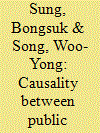

|
|
|
|
|
| Publication |
2013.
|
| Summary/Abstract |
This article investigates the causal relationship between public policies and exports of renewable energy technologies using panel data from 18 countries for the period 1991-2007. A number of panel unit root and cointegration tests are applied. Time series data on public policies and exports are integrated and cointegrated. The dynamic OLS results indicate that in the long run, a 1% increase in government R&D expenditures (RAD) increases exports (EX) by 0.819%. EX and RAD variables respond to deviations from the long-run equilibrium in the previous period. Additionally, the Blundell-Bond system generalized methods of moments (GMM) is employed to conduct a panel causality test in a vector error-correction mechanism (VECM) setting. Evidence of a bidirectional and short-run, and strong causal relationship between EX and the contribution of renewable energy to the total energy supply (CRES) is uncovered. CRES has a negative effect on EX, whereas EX has a positive effect on CRES. We suggest some policy implications based on the results of this study.
|
|
|
|
|
|
|
|
|
|
|
|
|
|
|
|
| 4 |
ID:
119802


|
|
|
|
|
| Publication |
2013.
|
| Summary/Abstract |
Pakistan is facing a severe electricity crisis due to a persistent and widening gap between demand and available system generating capacity. The worsening of power shortages has become a major political issue, reflecting the hardships for individuals and businesses. It threatens to undermine the credibility and legitimacy of government and to further stress the social fabric of the country. The power crisis did not emerge suddenly. It is the direct result of imprudent and reckless energy policies over the last three decades. These policies have impeded the development of cheap and abundant domestic energy sources. They have also resulted in very inefficient fuel-mix choices, compromising energy and economic security. Pakistan's energy bankruptcy is ultimately due to massive institutional and governance failure. This paper analyzes the problems confronting Pakistan's electricity sector and identifies the key elements of a potential policy response to address the country's severe power crisis.
|
|
|
|
|
|
|
|
|
|
|
|
|
|
|
|
| 5 |
ID:
119846


|
|
|
|
|
| Publication |
2013.
|
| Summary/Abstract |
In order to achieve energy consumption targets, and subsequently reduce carbon emissions, China is working on energy strategies and policies aimed at actively increasing the consumption of natural gas-the lowest carbon energy of the fossil fuels, and to enhance the proportion of gas in total primary energy consumption. To do this, it is a necessary prerequisite that China must have access to adequate gas resources and production to meet demand. This paper shows that the availability of domestic gas resources are overestimated by China's authorities due to differences in classification and definitions of gas resources/reserves between China and those accepted internationally. Based on official gas resource figures, China's gas production remains low with respect to the projected demand, and will only be 164.6 bcm in 2020, far lower than the 375 bcm of forecast demand. The gap between gas production and demand will reach 210.4 bcm by 2020. Existing plans for the importation of gas and the development of unconventional gas will not close this gap in the next 10 years, and this situation will therefore present a severe challenge to China's gas security, achievement of targets in improving energy consumption structure and reducing carbon emissions.
|
|
|
|
|
|
|
|
|
|
|
|
|
|
|
|
| 6 |
ID:
119794


|
|
|
|
|
| Publication |
2013.
|
| Summary/Abstract |
The Clean Development Mechanism (CDM) provides an institutional framework for developed countries to support projects that reduce greenhouse gas emissions in developing countries. Are the technologies promoted those most needed by the recipient countries? We address this question by first reviewing Technology Needs Assessments prepared by developing countries, and then comparing the stated needs to the technologies most frequently promoted via CDM. While there appears to be a good match between requested technologies and those used in CDM, desired technologies such as solar energy for remote locations, biofuels, improved cooking stoves, and efficient lighting appear "neglected" by CDM. Nonetheless, a review of costs for these technologies suggests that many could be cost effective for developing countries. For projects requiring wide dispersal of household items, such as cooking stoves or lighting, the administrative burdens of CDM provide a hurdle. In other cases, difficulties quantifying the ancillary benefits of these projects hinder the promotion of these technologies. We conclude with possible explanations for why these technologies are neglected and suggestions for future research.
|
|
|
|
|
|
|
|
|
|
|
|
|
|
|
|
| 7 |
ID:
119819


|
|
|
|
|
| Publication |
2013.
|
| Summary/Abstract |
Considering natural gas (NG) to be the most promising low-carbon option for the energy industry, large state owned companies in China have established numerous coal-based synthetic natural gas (SNG) projects. The objective of this paper is to use a system approach to evaluate coal-derived SNG in terms of life-cycle energy efficiency and CO2 emissions. This project examined main applications of the SNG and developed a model that can be used for evaluating energy efficiency and CO2 emissions of various fuel pathway systems. The model development started with the GREET model, and added the SNG module and an end-use equipment module. The database was constructed with Chinese data. The analyses show when the SNG are used for cooking, power generation, steam production for heating and industry, life-cycle energies are 20-108% higher than all competitive pathways, with a similar rate of increase in life-cycle CO2 emissions. When a compressed natural gas (CNG) car uses the SNG, life-cycle CO2 emission will increase by 150-190% compared to the baseline gasoline car and by 140-210% compared to an electric car powered by electricity from coal-fired power plants. The life-cycle CO2 emission of SNG-powered city bus will be 220-270% higher than that of traditional diesel city bus. The gap between SNG-powered buses and new hybrid diesel buses will be even larger-life-cycle CO2 emission of the former being around 4 times of that of the latter. It is concluded that the SNG will not accomplish the tasks of both energy conservation and CO2 reduction.
|
|
|
|
|
|
|
|
|
|
|
|
|
|
|
|
| 8 |
ID:
119786


|
|
|
|
|
| Publication |
2013.
|
| Summary/Abstract |
The distribution of the mitigation burden across countries is a key issue regarding the post-2012 global climate policies. This article explores the economic implications of alternative allocation rules, an assessment made in the run-up to the COP15 in Copenhagen (December 2009). We analyse the comparability of the allocations across countries based on four single indicators: GDP per capita, GHG emissions per GDP, GHG emission trends in the recent past, and population growth. The multi-sectoral computable general equilibrium model of the global economy, GEM-E3, is used for that purpose. Further, the article also compares a perfect carbon market without transaction costs with the case of a gradually developing carbon market, i.e. a carbon market with (gradually diminishing) transaction costs.
|
|
|
|
|
|
|
|
|
|
|
|
|
|
|
|
| 9 |
ID:
119828


|
|
|
|
|
| Publication |
2013.
|
| Summary/Abstract |
The construction time of PWRs is studied considering published data about nuclear power plants in the world. For the 268 PWRs in operation in 2010, the mode of the construction time distribution is around 5-6 years, and 80% of the plants were built in less than 120 months. To circumvent the problem of comparing plants with different size we normalized the construction time to plants with 1 GW. We restricted the analysis to 201 PWRs which suffered less from external factors that were beyond the control of the management from 1965 to 2010. The results showed that the normalized construction time did not increase over the years and nor with the plants' gross power level. The learning rate of the industry regarding normalized construction times showed a reduction with 95% confidence level of about 0.56±0.07 months for each 10 GW of installed capacity. Over the years the normalized construction time decreased and became more predictable. The data showed that countries with more centralized regulatory, construction and operation environments were able to build PWRs in shorter times. Countries less experienced with the nuclear technology built PWRs in longer times.
|
|
|
|
|
|
|
|
|
|
|
|
|
|
|
|
| 10 |
ID:
119823


|
|
|
|
|
| Publication |
2013.
|
| Summary/Abstract |
The paper investigates the contributions of foreign direct investment (FDI) net inflows to clean energy use, carbon emissions, and economic growth. The paper employs cointegration tests to examine a long-run equilibrium relationship among the variables and fixed effects models to examine the magnitude of FDI contributions to the other variables. The paper analyzes panel data of 19 nations of the G20 from 1971 to 2009. The test results indicate that FDI has played an important role in economic growth for the G20 whereas it limits its impact on an increase in CO2 emissions in the economies. The research finds no compelling evidence of FDI link with clean energy use. Given the results, the paper discusses FDI's potential role in achieving green growth goals.
|
|
|
|
|
|
|
|
|
|
|
|
|
|
|
|
| 11 |
ID:
119793


|
|
|
|
|
| Publication |
2013.
|
| Summary/Abstract |
Most modelling studies that explore emission mitigation scenarios only look into least-cost emission pathways, induced by a carbon tax. This means that European policies targeting specific - sometimes relatively costly - technologies, such as electric cars and advanced insulation measures, are usually not evaluated as part of cost-optimal scenarios. This study explores an emission mitigation scenario for Europe up to 2050, taking as a starting point specific emission reduction options instead of a carbon tax. The purpose is to identify the potential of each of these policies and identify trade-offs between sectoral policies in achieving emission reduction targets. The reduction options evaluated in this paper together lead to a reduction of 65% of 1990 CO2-equivalent emissions by 2050. More bottom-up modelling exercises, like the one presented here, provide a promising starting point to evaluate policy options that are currently considered by policy makers.
|
|
|
|
|
|
|
|
|
|
|
|
|
|
|
|
| 12 |
ID:
119814
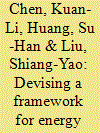

|
|
|
|
|
| Publication |
2013.
|
| Summary/Abstract |
Research has indicated that incorporating carbon reduction in the curriculum could improve awareness about energy conservation and related practices. Much research has been conducted on curriculum design and evaluation methods for energy education. However, a comprehensive view of the educational objectives for improving energy literacy is still lacking in these efforts. In this study, we propose a framework for energy education that clearly captures the concept of energy saving and carbon reduction by reviewing related literature and consulting an ad hoc panel of experts on energy and education. We then apply the analytic hierarchy process (AHP) to determine the indicators of the framework and their priority or weights. The results show that the dimensions of "civic responsibility for a sustainable society" and "low-carbon lifestyle" are considered most important as an energy educational goal. Among the indicators, "awareness and self-efficacy" and "identifying carbon-less technology and action plans" are ranked first and second. Application of this framework in K-12 curriculum and relevant educational issues are recommended.
|
|
|
|
|
|
|
|
|
|
|
|
|
|
|
|
| 13 |
ID:
119832
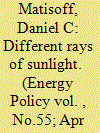

|
|
|
|
|
| Publication |
2013.
|
| Summary/Abstract |
This study assesses the effectiveness of two types information disclosure programs - state-based mandatory carbon reporting programs and the voluntary Carbon Disclosure Project, which uses investor pressure to push firms to disclose carbon emissions and carbon management strategies. I match firms in each program to control groups of firms that have not participated in each program. Using panel data methods and a difference in differences specification, I measure the impact of each program on plant-level carbon emissions, plant-level carbon intensity, and plant level output. I find that neither program has generated an impact on plant-level carbon emissions, emissions intensity, or output. Placing this study in contrast with others that demonstrate improvements from mandatory information disclosure, these results suggest that how information is reported to stakeholders has important implications for program effectiveness.
|
|
|
|
|
|
|
|
|
|
|
|
|
|
|
|
| 14 |
ID:
119780


|
|
|
|
|
| Publication |
2013.
|
| Summary/Abstract |
This research investigates if the stringent 2020 and 2050 overarching CO2 mitigation objectives set out by the European Union dominate its 2010 to 2020 targets specific to the transportation arena, specifically its biofuel penetration objectives and gram CO2per kilometre emission caps. Using a dynamic recursive general equilibrium model, IMACLIM-R, we demonstrate that these overarching targets do not dominate the interim transportation targets when the carbon policy triggering compliance with the mitigation objectives boils down to the theoretical least-cost option of uniform carbon pricing. Ground transportation is confirmed as quite insensitive to high carbon prices, even when such prices are applied over a long term. It is tempting to conclude that pursuing the mitigation objectives specific to transportation will impose unnecessary costs. However, because of the second best conditions prevailing in actual economies, and of the risk of lock-in in carbon intensive trajectories, we conclude with the urgent need for some ambitious transport-specific policy design research agenda.
|
|
|
|
|
|
|
|
|
|
|
|
|
|
|
|
| 15 |
ID:
119800
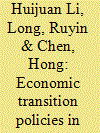

|
|
|
|
|
| Publication |
2013.
|
| Summary/Abstract |
Resource-based cities in China have made momentous contributions to the development of the national economy for decades. However, with the depletion of natural resources, their sustainable development is challenging and transition is important. The Chinese government has made great efforts to help resource-based cities. The purpose of this study is to investigate transition policies and their implementation. Firstly, we reviewed previous studies and summarized the essential elements of some successful resource-based cities, which are useful experiences for Chinese resource-based cities. Secondly, we studied the development of resource-based cities over the past 10 years with a focus on economic development, industrial structure, government revenue and environmental conditions. We found that resource-based cities were less developed compared to other cities. The main reasons are the after-effects of a planned economy, an unreasonable tax system, planning mistakes and misguided resources exploitation policies. Thirdly, we analyzed several aspects of the policy responses after the introduction of transition policies, including designating 69 resource-exhausted cities, supporting cities with funds and projects, formulating transition plans and evaluating transition performance. However, there are some deficiencies in the process of policy implementation. Finally, some recommendations were provided to improve transition performance and sustainable development for resource-based cities.
|
|
|
|
|
|
|
|
|
|
|
|
|
|
|
|
| 16 |
ID:
119839


|
|
|
|
|
| Publication |
2013.
|
| Summary/Abstract |
Argentina is one of the world's largest biodiesel producers and the largest exporter, using soybeans as feedstock. Using a computable general equilibrium model that explicitly represents the biofuel industry, this study carries out several simulations on two sets of issues: (i) international markets for biofuel and feedstock, such as an increase in prices of soybean, soybean oil, and biodiesel, and (ii) domestic policies related to biofuels, such as an introduction of biofuel mandates. Both sets of issues can have important consequences to the Argentinean economy. The simulations indicate that increases in international prices of biofuels and feedstocks would increase Argentina's gross domestic product and social welfare. Increases in international prices of ethanol and corn also can benefit Argentina, but to a lesser extent. The domestic mandates for biofuels, however, would cause small losses in economic output and social welfare because they divert part of biodiesel and feedstock from exports to lower-return domestic consumption. An increase in the export tax on either feedstock or biodiesel also would lead to a reduction in gross domestic product and social welfare, although government revenue would rise.
|
|
|
|
|
|
|
|
|
|
|
|
|
|
|
|
| 17 |
ID:
119803


|
|
|
|
|
| Publication |
2013.
|
| Summary/Abstract |
This article addresses the issue of electricity consumption, petroleum price and economic growth in Algeria. The primary objective is to investigate and analyze the causal relationship between electricity consumption (EC), Brent oil price (BOP) and economic growth (GDP) for Algeria over the period of 1971-2010. To examine short-run, long-run and joint causality relationships we used a multivariate cointegration approach based on the recent advances in time series econometrics (e.g., Zivot-Andrews test; Gregory-Hansen cointegration test; Vector Error Correction Models (VECM)). The empirical results show that there is evidence of short-run and a strong long-run bi-directional causal relationship between EC and real GDP in Algeria. Findings indicate also the absence of causal relationship between BOP and EC. Our empirical findings support the idea that there a link between electricity consumption and economic growth and disproves the neo-classical assumption referred to as the "neutrality hypothesis".
|
|
|
|
|
|
|
|
|
|
|
|
|
|
|
|
| 18 |
ID:
119783


|
|
|
|
|
| Publication |
2013.
|
| Summary/Abstract |
Emission trading systems have been proposed in different regions to reduce polluting emissions and are in use in the European Union for carbon dioxide emissions. One of the objectives of these systems is to encourage firms to adopt advanced abatement technologies. However, permits also create an incentive to reduce output, which may be seen as negative by policy makers. We analyze the impact of a rigid labour market on these two outcomes, showing the conditions necessary to avoid reductions in production while keeping the incentives to improve abatement technologies. The analysis is done for oligopolistic firms engaged in international rivalry.
|
|
|
|
|
|
|
|
|
|
|
|
|
|
|
|
| 19 |
ID:
119791


|
|
|
|
|
| Publication |
2013.
|
| Summary/Abstract |
Reducing the climate impact of rural household energy consumption in China is complicated since it is bound up with deeply routinized daily practices and dependent from existing infrastructural systems of energy supply. To assess the potential for low carbon development we first estimate the overall CO2 emissions of rural households, followed by a more in depth description and characterization of the different energy use practices within the households. Space heating turns out to be the largest emission source among domestic energy practices in north China. We present lifestyle and context related factors that help to explain existing differences in domestic energy use practices of households. The potential for low carbon development is discussed both at the demand side and the supply side. At the demand side, the use of more efficient technologies and cleaner energy sources for space heating seems to be a high potential measure for achieving low carbon households. At the supply side the reduction of rural domestic CO2 emissions could be effectively supported by making available to householders renewable and cleaner energy sources and technologies. In order to be effective, such low carbon energy options should take into account the (income) characteristics and lifestyles of rural householders.
|
|
|
|
|
|
|
|
|
|
|
|
|
|
|
|
| 20 |
ID:
119795
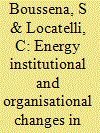

|
|
|
|
|
| Publication |
2013.
|
| Summary/Abstract |
This article tries to shed light on why gas relations between the EU and Russia, which were previously stable, have deteriorated since the introduction of institutional changes in the two regions. After identifying the areas of divergence in the context of European gas market liberalization, we then attempt to examine them in the context of the differing approaches to structuring this sector. The model of vertically unbundled network industries promoted by the EU is no longer the one that Russia intends to implement in its gas sector, despite the big changes taking place in its domestic market. All this is happening in a context where the economic stakes are very high. For the EU and its gas companies, access to Russia's hydrocarbon resources is a key question. For Gazprom, the question is whether or not it can define strategies that are flexible enough to adapt to the changing conditions in the European gas market.
|
|
|
|
|
|
|
|
|
|
|
|
|
|
|
|
|
|
|
|
|